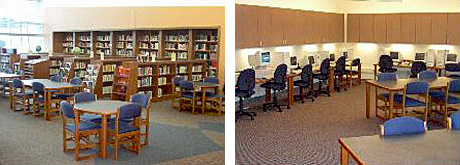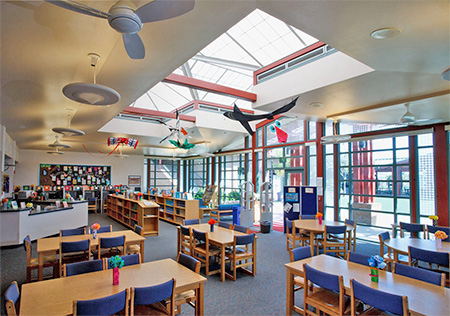Overview
Within This Page
School libraries differ from most other types of libraries because they are contained within school buildings, which, in addition to library space, may include classrooms, auditoriums, circulation space, administrative offices, cafeterias, and the like. As a result, school libraries, or library media centers (LMCs) as they are commonly called, are smaller than their counterparts. Appropriate space planning for present needs and future expansion is imperative in the school library program. According to a study by the Wisconsin Department of Public Instruction, computer and video technology, in addition to other forms of media including print material, is an important part of education. Use of technology in classrooms and in the library must include design aspects that support learning, including adjustable lighting, ample electrical connections, sound control, and space for expansion. School library space must also accommodate computer learning that is separated from quiet reading, group study, circulation, reference work, and other learning activities.

Robert J. Elkington Middle School Library, Grand Rapids, MN
Building Attributes
A. Types of Spaces
There are many broad types of school library space:
- Collection space
- Electronic workstation space
- User seating space
- Staff work space
- Meeting space
- Special use space
- Non-assignable space (including mechanical space)
In addition, library media centers need the following:
- Space to separate activities that interfere with each other (see also WBDG Functional / Operational—Account for Functional Needs);
- Ample electrical outlets and circuits (walls, floors, and ceiling);
- Open design, few walls, relocatable partitions (see also WBDG Productive—Design for the Changing Workplace);
- Multiple telephone lines for voice, data, and intercom connections;
- Appropriate cable connections for video and data transmission (see also WBDG Productive—Integrate Technological Tools);
- Conference rooms with access to video and data transmission;
- Acoustical treatment on walls, ceilings, and floors (see also WBDG Productive—Provide Comfortable Environments);
- The ability to install cubicle partitions, some with electrical wiring extensions;
- Video production areas;
- Adjustable lighting (see also WBDG Energy Efficient Lighting and Electric Lighting Controls; and
- Generous space for staff work areas (see also WBDG Productive and Functional / Operational).
Emerging Issues
In addition to the emerging issues of sustainable design and wiring technology to accommodate modern communications (see Public Library: Emerging Issues), and digital media and the space required to accommodate it (see Academic Library: Emerging Issues), connecting classrooms to the library and to outlets for distance learning is an emerging issue in school media center design. As outlined in Classrooms, Library Media Centers, and New Technology, a study by the Wisconsin Department of Public Instruction, some other design considerations include:
- Space for future cabling;
- Rooms for file servers and other equipment;
- Surge protectors and uninterruptible power supply; and
- A detained map of the network.
Increasingly, school curricula are based on collaborative and group projects. As a result, there is less and less emphasis on traditional, individual study settings, such as long rows of individual study carrels. Instead, school libraries are developing learning centers, which provide group study rooms and settings, well-supported by access to electronic information resources, hardware tools, and associated productivity software.

Daylighting at Coronado Middle School
Photo Credit: Architects Mosher, Drew, Watson, Ferguson
Relevant Codes and Standards
Model Building Codes that may apply include the following (check with local building departments for code requirements):
Note: Some states have their own state-written building codes. In addition, some localities have their own local codes. State and local building departments are the best resource for applicable codes.
- Americans with Disabilities Act (ADA)
- American with Disabilities Act Accessibility Guidelines (ADAAG)
- Architectural Barriers Act (ABA)
Also note that the American Library Association, Building and Equipment Section has published a guide to recommended space allocations for furnishings, equipment, and resources to be housed in the library:
- Building Blocks for Planning Functional Library Space 3rd Edition, Scarecrow Press, 2011.
Additional Resources
Associations
Publications
- Classrooms, Library Media Centers, and New Technology, by the Wisconsin Department of Public Instruction.
- Designing a School Library Media Center for the Future: Second Edition by Rolf Erikson and Carolyn Markuson. Chicago, IL: American Library Association, 2007.
- Designing and Renovating School Library Media Centers by Jane P. Klasing. Chicago, IL: American Library Association, 1991.
- The Power of Paint: Refurbishing School Libraries on a Budget by Marian D. Usalis. School Library Journal, 28 February 1998: 28-33.








